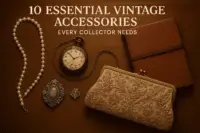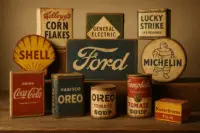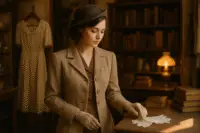Floral patterns have evolved dramatically over time, reflecting changes in society, art, and technology. From the handcrafted luxury of the Victorian era to the bold statements of the mid-20th century and today’s eco-conscious digital designs, florals have remained a key element in fashion. Here’s a quick overview of their journey:
- Victorian Era: Dense, opulent patterns symbolized wealth and formality.
- Art Nouveau: Flowing, nature-inspired designs with softer, organic forms.
- Mid-20th Century: Florals became mainstream, shifting from feminine domesticity to bold counterculture statements.
- Late 20th Century: Revival of vintage motifs with modern twists, reflecting nostalgia and rebellion.
- Modern Era: Digital printing enables photorealistic designs, with a focus on sustainability and bold, experimental styles.
Floral prints continue to blend historical influences with modern techniques, offering timeless appeal across generations.
1930s & 1940s Dress Prints Lesson | Fashion History Series with Ian Drummond
1. Victorian and Art Nouveau Eras
The Victorian and Art Nouveau periods marked a fascinating evolution in floral print design, transitioning from intricate opulence to refined elegance. These shifts reflected broader societal changes and artistic movements, which left their imprint on the patterns and styles of the time.
Historical Context
During the Victorian era, society was steeped in formality and rigid social structures. Floral designs became a way for the upper class to flaunt their wealth, with elaborate, densely packed patterns symbolizing abundance and prosperity.
Art Nouveau, on the other hand, emerged as a reaction against the strict conventions of the Victorian age. This movement embraced nature and craftsmanship, breaking away from academic traditions. It signaled a fresh artistic approach, which naturally influenced floral motifs and their composition.
Design Elements
Victorian floral prints were the epitome of extravagance. They featured tightly arranged clusters of flowers such as roses, tulips, carnations, daisies, lilies, peonies, and baby’s breath. These blooms were often accompanied by lush greenery like ferns and ivy, creating rich, overflowing designs.
Art Nouveau took a different path, favoring open, flowing designs characterized by graceful lines and “whiplash curves.” Inspired by Japanese woodblock prints, these patterns showcased fluid, organic forms. Common motifs included ranunculus, callas, kiwi branches, daffodils, hellebores, pansies, irises, and chrysanthemums, all depicted with curving, spiraling stems. The contrast in design extended to the use of color, which further distinguished the two eras.
Color Palette
Victorian floral prints leaned into bold contrasts and vivid hues, aiming for dramatic visual appeal. Early designs often paired deep, rich colors with gold accents, while later works shifted to lighter tones with silver highlights and a greater focus on texture.
In contrast, Art Nouveau adopted a more subdued and naturalistic color scheme. Blues, greens, and muted tones became the norm, reflecting the movement’s emphasis on harmony with nature. This softer palette stood in stark contrast to the bold and dramatic colors of the Victorian period.
2. Mid-20th Century Flower Power
In the mid-20th century, floral prints transformed from symbols of refined elegance into bold statements of rebellion and individuality. During this period, these patterns became deeply tied to cultural shifts and social movements, reflecting a dynamic era of change.
Historical Context
From the 1940s through the 1970s, American society and its fashion underwent significant transformations. Following World War II, the late 1940s and 1950s were marked by optimism and a focus on prosperity. Floral prints during this time often symbolized domesticity and femininity, with cheerful designs that celebrated peacetime stability.
By the 1960s, the counterculture movement gave floral prints a whole new meaning. They became iconic symbols of peace, love, and anti-war sentiment, closely linked to the “Flower Power” movement. As the 1970s began, these bold patterns also reflected the feminist movement, as women embraced striking designs to express independence and challenge traditional norms. This cultural awakening was mirrored in the era’s fashion and design choices.
Design Elements
Mid-century floral designs broke away from the formal, structured patterns of earlier eras. In the 1950s, florals often featured medium-scale, realistic botanical details, showcasing garden staples like roses, daisies, and peonies arranged in balanced, harmonious layouts.
The 1960s brought a radical shift, with psychedelic interpretations of florals taking center stage. Designers experimented with abstract, geometric forms and surreal, exaggerated shapes that captured the era’s spirit of creativity and experimentation. By the late 1960s and into the 1970s, oversized floral prints dominated, reflecting a growing fascination with global influences and a desire for bold self-expression.
Color Palette
The 1950s favored soft, delicate hues like powder blue, mint green, coral pink, and butter yellow – tones that echoed the era’s optimism and femininity. In contrast, the 1960s embraced a riot of saturated colors, including hot pinks, lime greens, electric blues, and vibrant oranges, creating eye-catching combinations that mirrored the decade’s energy. By the 1970s, the palette evolved to include earthy tones like burnt orange and forest green, aligning with a rising interest in nature and environmental awareness.
Material and Technique
Advancements in textile technology played a key role in redefining floral prints during this time. The introduction of synthetic fabrics like polyester and nylon allowed for vibrant, durable designs that retained their color over time. Screen printing techniques became more refined, enabling intricate, multi-layered patterns with high precision and sharp color contrasts.
Heat-transfer printing further expanded creative possibilities, paving the way for the expressive and experimental patterns that defined the era. While cotton remained a favorite for casual wear, synthetic blends gained popularity for their durability and comfort, making bold floral prints more accessible for everyday fashion.
3. Late 20th Century Revival
The 1980s and 1990s marked a turning point for floral prints, as designers revisited the past to give vintage motifs a modern twist. This era of revival transformed florals into bold statements, blending nostalgia with contemporary trends.
Historical Context
This revival was rooted in a mix of longing for the past and a push against the status quo. The booming economy of the 1980s brought a craving for luxury, prompting fashion houses to reimagine the delicate florals of previous decades. Floral prints became a softer, more refined complement to the decade’s signature power dressing, with its sharp-shouldered blazers and tailored silhouettes.
By the 1990s, the grunge movement flipped the script on floral fashion. Young Americans began pairing flowy floral dresses with edgy pieces like combat boots and leather jackets, creating a striking contrast that defied traditional feminine norms. Thrifted vintage florals became staples for Generation X, who prioritized individuality and authenticity over flashy designer labels.
At the same time, the “shabby chic” trend gained traction in interior design and spilled into fashion. Faded floral patterns, evoking English gardens or Victorian parlors, struck a chord with those seeking comfort and romance in an increasingly tech-driven world. This shift inspired designers to reinterpret classic floral styles in fresh, unexpected ways.
Design Elements
Floral prints of the late 20th century brought traditional influences into a modern context. In the 1980s, medium-scale florals with clean, defined edges became popular, complementing the structured clothing of the time. Roses, peonies, and cabbage roses were especially favored, often arranged in formal, bouquet-like patterns.
The 1990s took a more eclectic approach. Designers began mixing floral scales within a single garment, combining tiny ditsy prints with oversized botanical motifs. Vintage-inspired prints also made a comeback, with new fabrics designed to mimic the worn, faded look of antique textiles. Layered floral patterns with varied textures and color palettes created a rich, maximalist aesthetic.
Color Palette
The 1980s embraced bold, jewel-toned florals that matched the decade’s vibrant energy. Deep burgundy, emerald green, sapphire blue, and rich purple were common, often set against creamy or ivory backgrounds. These dramatic combinations appealed to professional women looking for polished alternatives to solid-colored business wear.
In contrast, the 1990s shifted to softer, muted tones influenced by the grunge movement. Sage green, dusty rose, faded lavender, and cream dominated, giving floral prints a “worn-in” feel. This lived-in look became so popular that manufacturers developed special washing techniques to achieve the effect on new fabrics.
Material and Technique
Advancements in textile technology during this period played a big role in shaping floral fashion. The early 1990s saw the rise of digital printing, which made it easier to reproduce intricate vintage patterns with precision. This innovation also allowed for smaller production runs, enabling designers to create limited-edition floral prints inspired by historical designs.
Rayon and viscose became popular choices for their affordability, natural drape, and ability to hold vibrant colors, making them ideal for the era’s flowing silhouettes. Meanwhile, blends like cotton-silk gained attention for their durability and luxurious texture, reflecting the decade’s renewed interest in natural fibers.
4. Modern Floral Trends
Floral prints in the 21st century bring together digital innovation and a focus on eco-conscious design. Today’s floral fashion merges age-old botanical patterns with cutting-edge technology, all while reflecting a growing emphasis on sustainability. These trends build on historical changes, blending traditional styles with modern techniques to create something fresh and relevant.
Historical Context
The modern floral movement took off in the early 2000s, fueled by the rise of fast fashion. Platforms like Instagram and Pinterest have since accelerated the spread of floral trends, shrinking the gap between runway debuts and retail shelves. This instant global reach has shaped demand for specific styles almost overnight.
At the same time, the growing sustainability movement has reshaped how designers think about floral prints. With consumers becoming more conscious of fashion’s environmental footprint, brands have shifted their focus toward greener production methods. This change aligns with the slow fashion movement, which prioritizes quality and timeless designs over short-lived trends.
Climate change awareness has also left its mark on floral design. Many designers now draw inspiration from endangered plants and fragile ecosystems, using their work to raise awareness and promote environmental responsibility.
Design Elements
Modern floral prints embrace photorealism, made possible by advanced digital printing. Close-up details – like petals, stamens, and leaves – capture nature’s complexity, often inspired by macro photography.
Designers also experiment with mixed-media styles, combining traditional floral patterns with geometric shapes, abstract elements, or typography. Minimalist aesthetics, featuring sparse floral arrangements against clean backgrounds, offer a sleek and understated look. On the other hand, oversized botanical prints, where a single bold flower dominates an entire garment, stand in stark contrast to the tiny, delicate patterns popular in earlier decades.
Color Palette
Today’s floral designs play with bold, high-contrast colors like electric blue, vibrant orange, and hot pink, perfect for grabbing attention on social media. Monochromatic schemes and neon accents also deliver a striking, modern edge.
Earthy tones, such as sage green, terracotta, and warm browns, remain popular too, appealing to those who appreciate natural, grounded aesthetics and a deeper connection to the environment.
Material and Technique
Modern floral fashion continues to innovate by combining sustainability with precision. Digital printing offers endless color possibilities on eco-friendly fabrics like organic cotton, Tencel, and recycled polyester. Performance textiles with features like moisture-wicking and stretch add functionality, while smart textiles – including LED elements – push floral design into futuristic territory. On-demand digital printing reduces waste and allows for customization, something traditional methods often struggle to achieve.
Emerging technologies like 3D printing are also making waves. Designers are experimenting with raised textures and dimensional elements, bringing a tactile and sculptural quality to floral patterns that redefine how we experience them.
Pros and Cons
Floral fashion has evolved through the ages, with each era bringing its own perks and challenges. These shifts were influenced by advancements in technology, societal trends, and economic factors. By looking at these trade-offs, it’s easier to understand why certain floral styles flourished while others faded into history.
| Era | Pros | Cons |
|---|---|---|
| Victorian & Art Nouveau | Known for its intricate, hand-painted designs and luxurious natural fabrics, this era showcased exceptional craftsmanship. | The labor-intensive process and reliance on high-end materials made these designs accessible to only a select few. |
| Mid-20th Century Flower Power | Mass production brought floral prints to the mainstream, and the bold, vibrant patterns perfectly captured the energy of the time. | Printing technology of the era limited color options, and synthetic fabrics often sacrificed comfort for affordability. |
| Late 20th Century Revival | Designer collaborations and improved printing techniques offered more intricate patterns and a wider variety of fabrics. | Fast-changing trends and widespread imitation led to overproduction and raised concerns about environmental impact. |
| Modern Era | Digital printing allows for highly detailed, photorealistic designs, while sustainable fabrics and on-demand production help minimize waste. | Advanced production methods require significant investment, and the rapid pace of trends puts constant pressure on designers to keep up. |
Floral design continues to balance artistry, accessibility, and sustainability. High-quality pieces often stand the test of time, making vintage floral designs a favorite in today’s resale market.
While digital printing has overcome past challenges like limited color variety and pattern complexity, it also demands constant evolution. These ongoing innovations and compromises highlight how each era contributes to the ever-changing legacy of floral prints.
Conclusion
Floral prints have stood the test of time, weaving their way through over a century of fashion changes. From the delicate hand-painted motifs of the Victorian era to today’s intricate digital designs, these patterns have evolved with the times while maintaining their timeless appeal.
Each period brought its own innovations and challenges. The Victorian age established florals as symbols of luxury and elegance, though they were reserved for the privileged few. By the mid-20th century, mass production made these designs accessible to the everyday consumer, ushering in the era of bold, expressive “flower power” patterns. Later, the late 20th century elevated florals as a form of high art, and today, designers are blending creativity with a focus on sustainability.
This journey through history offers valuable insights for both collectors and designers. Collectors can better appreciate the craftsmanship and historical significance of pieces from different periods, while modern designers can draw inspiration from past techniques and innovations, learning from the successes and limitations of earlier eras. Floral prints serve as a bridge, linking the artistry of the past with the technological advancements shaping today’s fashion.
What makes floral patterns so enduring is their ability to adapt and resonate emotionally. They’ve weathered countless trends, embraced new technologies, and reflected shifting social values. As fashion continues to evolve, florals remain a constant – a design element that connects the craftsmanship of the past with the innovations of the future.
FAQs
How has technology like digital printing transformed floral print designs in modern fashion?
Digital printing has transformed the way floral print designs are created, allowing for intricate patterns, bold colors, and textures that feel almost lifelike. Designers can now explore both realistic and abstract floral motifs, opening up creative possibilities that were once hard to achieve.
On top of that, technologies like 3D printing and digital design tools have introduced new ways to approach floral patterns. These tools make it easier to produce unique, customizable designs, blending traditional floral elements with a modern twist. The result? A streamlined process that breathes new life into classic floral prints while keeping them relevant and contemporary.
How have cultural and societal changes shaped floral prints from the Victorian era to today?
Floral prints have gone through a fascinating transformation, shaped by the changing tides of society and style. Back in the Victorian era, these patterns were a hallmark of luxury and femininity, heavily influenced by the period’s obsession with nature and botanical exploration. The designs were often intricate, reflecting the strict gender norms and societal values of the time.
Fast forward to the 20th century, and floral prints took on a life of their own. The 1960s brought bold, colorful patterns tied to the flower power movement, symbolizing freedom and rebellion. Today, floral designs have embraced a sleeker, more modern aesthetic influenced by technology and minimalism. Advances in fabric production and printing have made these patterns more varied and accessible than ever, reflecting global influences and a shift toward personal expression. Each era has left its stamp, weaving floral prints into a story of history and evolving style.
How do today’s floral prints reflect the growing focus on sustainability and eco-friendly practices?
Modern floral prints are stepping into a greener future by incorporating earth-friendly materials such as organic cotton, hemp, and Tencel. On top of that, many are turning to natural dyes to cut down on harmful environmental effects. These thoughtful choices help reduce waste and cater to the increasing desire for ethical and responsible fashion.
Designers are drawing inspiration straight from nature, weaving botanical patterns into their creations that not only celebrate the beauty of the natural world but also emphasize sustainability. This trend reflects a deeper dedication to mindful design and production methods, paving the way for a fashion industry that prioritizes the planet.



